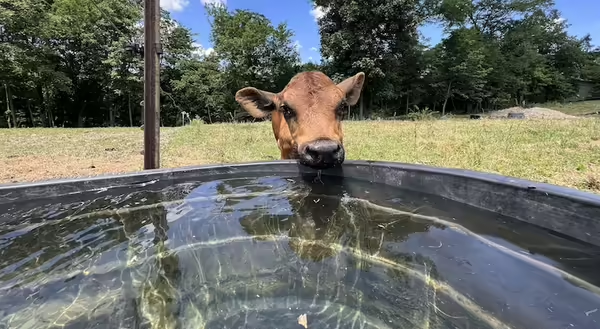
As high summer temperatures continue, it is important to ensure water quality levels are in the appropriate range. Beef cattle require one-to-two gallons of water per 100 pounds of body weight, but this amount increases during summer months and different stages of cattle. When water quality diminishes, intake levels decrease which can affect cattle performance, growth, and proper functions within their body. These issues can threaten the health of cattle along with producer profits.
Water Quality Factors
There are several main factors contributing to the assessment of water quality. Total dissolved solids (TDS) measures components dissolved in water, determining if water is acceptable for cattle to drink. Nitrate levels in water are more common to rise during drought conditions when water becomes more shallow. Monitoring nitrate levels is essential in these conditions because certain feed or forage contains high levels of nitrates which can become toxic when combined. Sulfates bind to minerals in water, which can eventually result in excessive salt leaving a bitter taste cattle are not fond of. The main concerns of high sulfate levels is the strong laxative effect and polioencephalomalacia, which can lead to brain lesions. Blue-green algae can produce toxins affecting the nerves and liver. This is a main concern during summer or early fall when the algae is blooming rapidly on the surface of water.
Below are recommended levels for water quality:
- TDS: 3,000 ppm or less
- Nitrates: 100 ppm or less
- Sulfates: <500 ppm for calves, <1,000 ppm for adults
- pH: 6.5 - 8.0
How to Test Water Quality
Water quality can be checked using a livestock water analysis. It is recommended this analysis should test for TDS, nitrates, sulfates, salinity, coliform bacteria, pH, and other toxicity threats such as blue-green algae or pesticides. When collecting a water sample, rinse the container several times before filling and be sure to collect from the surface and deeper. Once the samples are secured and labeled, a certified laboratory or local extension office can help take the next steps in the testing process.
Summary
Water can often be overlooked as a nutrient in livestock, especially during summer months. Beef cattle water requirements can double when temperatures increase or during different stages of their life. This means that automatic waterers need to be checked regularly to guarantee they provide adequate flow rates to meet the herd’s needs. Ensuring proper water quality can help avoid toxicity, allowing performance, growth, and profits a better chance of improvement.
ABOUT: Payton Block is a student at the University of Illinois Urbana-Champaign who works in beef production, research, and producer outreach as a University of Illinois Extension intern in the I-BELIEF program through the Department of Animal Sciences in the College of Agricultural, Consumer and Environmental Sciences. This article has been reviewed by Extension Commercial Agriculture Educator, Travis Meteer.